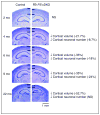Presenilins in synaptic function and disease
- PMID: 21795114
- PMCID: PMC3205282
- DOI: 10.1016/j.molmed.2011.06.002
Presenilins in synaptic function and disease
Abstract
The presenilin genes harbor approximately 90% of mutations linked to early-onset familial Alzheimer's disease (FAD), but how these mutations cause the disease is still being debated. Genetic analysis in Drosophila and mice demonstrate that presenilin plays essential roles in synaptic function, learning and memory, as well as neuronal survival in the adult brain, and the FAD-linked mutations alter the normal function of presenilin in these processes. Presenilin has also been reported to regulate the calcium homeostasis of intracellular stores, and presynaptic presenilin controls neurotransmitter release and long-term potentiation through modulation of calcium release from intracellular stores. In this review, we highlight recent advances in deciphering the role of presenilin in synaptic function, calcium regulation and disease, and pose key questions for future studies.
Copyright © 2011 Elsevier Ltd. All rights reserved.
Conflict of interest statement
The authors have no conflicts of interest to declare.
Figures



Similar articles
-
Familial Alzheimer's disease-linked presenilin mutants and intracellular Ca2+ handling: A single-organelle, FRET-based analysis.Cell Calcium. 2019 May;79:44-56. doi: 10.1016/j.ceca.2019.02.005. Epub 2019 Feb 23. Cell Calcium. 2019. PMID: 30822648
-
Familial Alzheimer's disease-associated presenilin-1 alters cerebellar activity and calcium homeostasis.J Clin Invest. 2014 Apr;124(4):1552-67. doi: 10.1172/JCI66407. Epub 2014 Feb 24. J Clin Invest. 2014. PMID: 24569455 Free PMC article.
-
Exploring the Role of PSEN Mutations in the Pathogenesis of Alzheimer's Disease.Neurotox Res. 2020 Dec;38(4):833-849. doi: 10.1007/s12640-020-00232-x. Epub 2020 Jun 18. Neurotox Res. 2020. PMID: 32556937 Review.
-
Presenilin mutations linked to familial Alzheimer's disease reduce endoplasmic reticulum and Golgi apparatus calcium levels.Cell Calcium. 2006 Jun;39(6):539-50. doi: 10.1016/j.ceca.2006.03.002. Epub 2006 Apr 18. Cell Calcium. 2006. PMID: 16620965
-
Neuronal calcium signaling and Alzheimer's disease.Adv Exp Med Biol. 2012;740:1193-217. doi: 10.1007/978-94-007-2888-2_54. Adv Exp Med Biol. 2012. PMID: 22453989 Review.
Cited by
-
Bax inhibitor 1 is a γ-secretase-independent presenilin-binding protein.Proc Natl Acad Sci U S A. 2019 Jan 2;116(1):141-147. doi: 10.1073/pnas.1810870116. Epub 2018 Dec 17. Proc Natl Acad Sci U S A. 2019. PMID: 30559186 Free PMC article.
-
Presenilins regulate neurotrypsin gene expression and neurotrypsin-dependent agrin cleavage via cyclic AMP response element-binding protein (CREB) modulation.J Biol Chem. 2013 Dec 6;288(49):35222-36. doi: 10.1074/jbc.M113.513705. Epub 2013 Oct 21. J Biol Chem. 2013. PMID: 24145027 Free PMC article.
-
Partial loss of presenilin impairs age-dependent neuronal survival in the cerebral cortex.J Neurosci. 2014 Nov 26;34(48):15912-22. doi: 10.1523/JNEUROSCI.3261-14.2014. J Neurosci. 2014. PMID: 25429133 Free PMC article.
-
The very many faces of presenilins and the γ-secretase complex.Protoplasma. 2013 Oct;250(5):997-1011. doi: 10.1007/s00709-013-0494-y. Epub 2013 Mar 16. Protoplasma. 2013. PMID: 23504135 Free PMC article. Review.
-
Presenilin 2 influences miR146 level and activity in microglia.J Neurochem. 2013 Dec;127(5):592-9. doi: 10.1111/jnc.12400. Epub 2013 Sep 30. J Neurochem. 2013. PMID: 23952003 Free PMC article.
References
-
- Scheff SW, et al. Hippocampal synaptic loss in early Alzheimer’s disease and mild cognitive impairment. Neurobiol Aging. 2006;27:1372–1384. - PubMed
-
- Amtul Z, et al. A presenilin 1 mutation associated with familial frontotemporal dementia inhibits gamma-secretase cleavage of APP and notch. Neurobiol Dis. 2002;9:269–273. - PubMed
-
- Dermaut B, et al. A novel presenilin 1 mutation associated with Pick’s disease but not beta-amyloid plaques. Ann Neurol. 2004;55:617–626. - PubMed
-
- Raux G, et al. Dementia with prominent frontotemporal features associated with L113P presenilin 1 mutation. Neurology. 2000;55:1577–1578. - PubMed
-
- Lee VM, et al. Neurodegenerative tauopathies. Annu Rev Neurosci. 2001;24:1121–1159. - PubMed
Publication types
MeSH terms
Substances
Grants and funding
LinkOut - more resources
Full Text Sources
Medical

